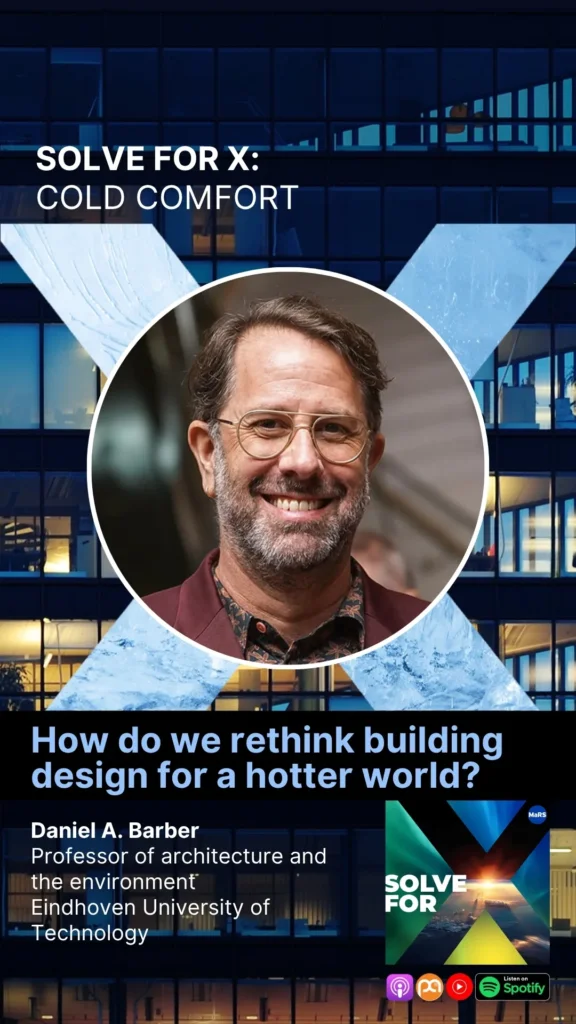Home » Designing Buildings for Energy Efficiency: Can We Reduce Cooling Energy Use? – S3E10
Designing Buildings for Energy Efficiency: Can We Reduce Cooling Energy Use? – S3E10

In the post "Solve for X – S3E10 | Can we design buildings to use less cooling energy?" from MaRS Discovery District, the discussion focuses on the ongoing challenge of energy consumption in buildings, particularly concerning cooling demands. As global temperatures rise, the need for effective cooling solutions becomes increasingly critical. The traditional methods of cooling, which heavily rely on mechanical systems, contribute significantly to energy consumption and greenhouse gas emissions.
The episode invites experts to explore innovative designs and technologies that can minimize the cooling energy required in buildings. Key points include the importance of passive design strategies, which utilize natural elements—like sunlight, air flow, and thermal mass—to maintain comfortable indoor temperatures. By focusing on these strategies, architects and builders can create environments that need less active cooling, thus reducing energy usage.
One example discussed highlights the role of building orientation and shading. The positioning of a building can significantly affect how much sunlight it absorbs. Effective shading devices can mitigate heat gain while still allowing natural light into the space, enhancing occupant comfort without compromising energy efficiency.
Another crucial aspect brought to light is the selection of materials used in construction. High-performance insulation, reflective roofing, and thermally massed materials can all contribute to an overall reduction in cooling loads. By integrating materials that naturally regulate temperature, buildings can maintain a more stable climate that lessens reliance on air conditioning systems.
The episode also examines the concept of "green roofs," which are becoming increasingly popular in urban environments. These roofs not only provide insulation but also help to cool the surrounding area through the evaporation of moisture. This dual benefit exemplifies how building design can positively impact both energy efficiency and local microclimates.
Furthermore, the experts underscore the significance of landscaping in building design. Strategically planted trees and vegetation can provide shade and reduce heat accumulation around buildings, enhancing their cooling effects. This natural intervention complements architectural solutions, showcasing the interconnected nature of ecological design.
Policy implications and incentives for implementing energy-efficient cooling designs are also discussed. The post emphasizes the necessity for governmental support and frameworks that encourage sustainable building practices. Incentives can drive innovation and facilitate the transition towards a more energy-efficient construction industry.
Throughout the episode, a recurring theme is the balance between aesthetics, functionality, and sustainability. While innovative designs contribute to energy savings, they must also meet the needs and expectations of occupants and communities. This holistic approach encourages a shift in mindset amongst stakeholders in the building sector, promoting a culture of sustainability that prioritizes long-term environmental health.
The culmination of insights presented paints a hopeful picture of what the future holds for building design. By adopting forward-thinking approaches that leverage natural systems and advanced technologies, the construction industry can significantly decrease its energy footprint. Architects, engineers, and developers are urged to rethink traditional methodologies, emphasizing that sustainable building practices can lead not only to reduced energy use but also to healthier living environments.
In summary, the conversation reveals the potential for transforming how buildings are designed to significantly lessen cooling energy demands, aligning architectural advancement with vital ecological considerations. This episode serves as a clarion call for industry-wide change, urging all stakeholders to embrace and implement these innovative strategies for a more sustainable future.
MaRS Discovery District
https://www.marsdd.com/
MaRS is the world's largest urban innovation hub in Toronto that supports startups in the health, cleantech, fintech, and enterprise sectors. When MaRS opened in 2005 this concept of urban innovation was an untested theory. Today, it’s reshaping cities around the world. MaRS has been at the forefront of a wave of change that extends from Melbourne to Amsterdam and runs through San Francisco, London, Medellín, Los Angeles, Paris and New York. These global cities are now striving to create what we have in Toronto: a dense innovation district that co-locates universities, startups, corporates and investors. In this increasingly competitive landscape, scale matters more than ever – the best talent is attracted to the brightest innovation hotspots.


